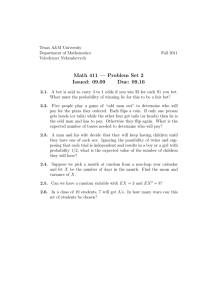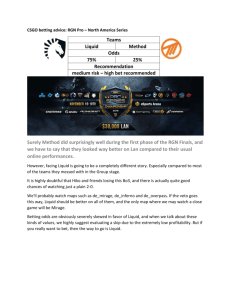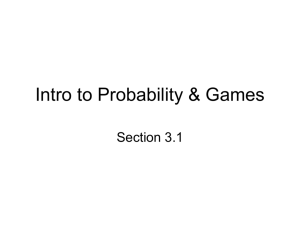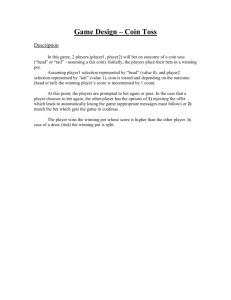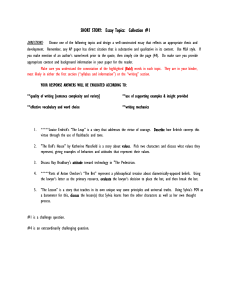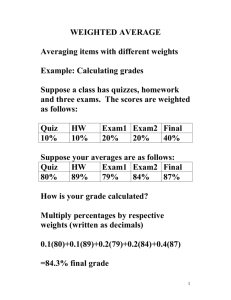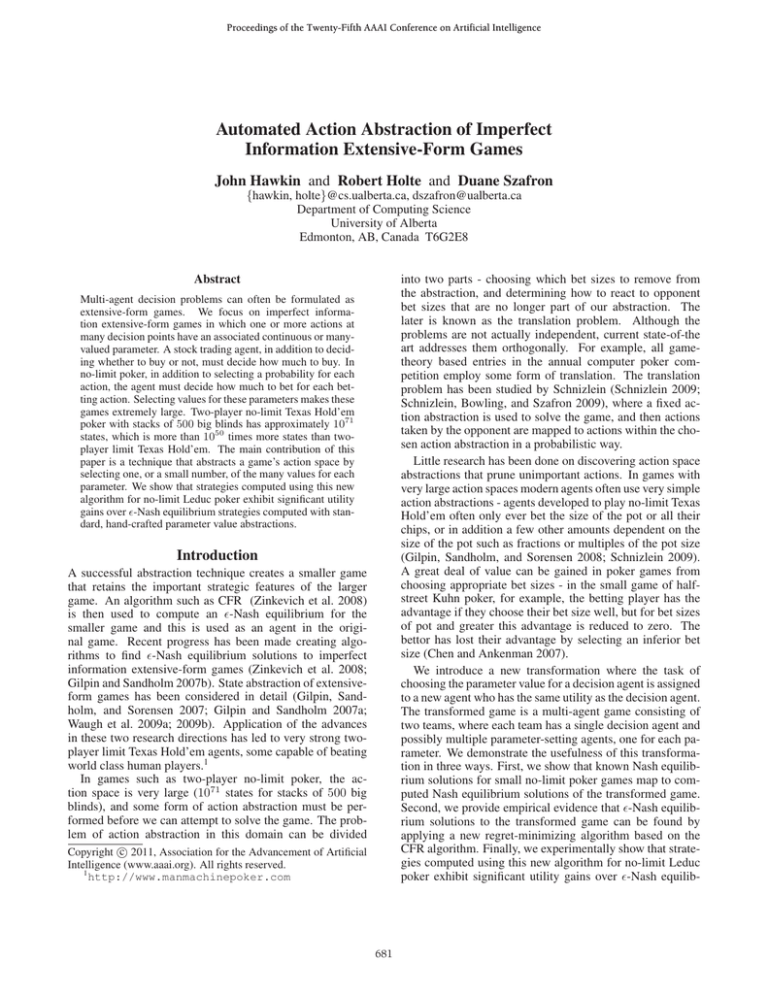
Proceedings of the Twenty-Fifth AAAI Conference on Artificial Intelligence
Automated Action Abstraction of Imperfect
Information Extensive-Form Games
John Hawkin and Robert Holte and Duane Szafron
{hawkin, holte}@cs.ualberta.ca, dszafron@ualberta.ca
Department of Computing Science
University of Alberta
Edmonton, AB, Canada T6G2E8
into two parts - choosing which bet sizes to remove from
the abstraction, and determining how to react to opponent
bet sizes that are no longer part of our abstraction. The
later is known as the translation problem. Although the
problems are not actually independent, current state-of-the
art addresses them orthogonally. For example, all gametheory based entries in the annual computer poker competition employ some form of translation. The translation
problem has been studied by Schnizlein (Schnizlein 2009;
Schnizlein, Bowling, and Szafron 2009), where a fixed action abstraction is used to solve the game, and then actions
taken by the opponent are mapped to actions within the chosen action abstraction in a probabilistic way.
Little research has been done on discovering action space
abstractions that prune unimportant actions. In games with
very large action spaces modern agents often use very simple
action abstractions - agents developed to play no-limit Texas
Hold’em often only ever bet the size of the pot or all their
chips, or in addition a few other amounts dependent on the
size of the pot such as fractions or multiples of the pot size
(Gilpin, Sandholm, and Sorensen 2008; Schnizlein 2009).
A great deal of value can be gained in poker games from
choosing appropriate bet sizes - in the small game of halfstreet Kuhn poker, for example, the betting player has the
advantage if they choose their bet size well, but for bet sizes
of pot and greater this advantage is reduced to zero. The
bettor has lost their advantage by selecting an inferior bet
size (Chen and Ankenman 2007).
We introduce a new transformation where the task of
choosing the parameter value for a decision agent is assigned
to a new agent who has the same utility as the decision agent.
The transformed game is a multi-agent game consisting of
two teams, where each team has a single decision agent and
possibly multiple parameter-setting agents, one for each parameter. We demonstrate the usefulness of this transformation in three ways. First, we show that known Nash equilibrium solutions for small no-limit poker games map to computed Nash equilibrium solutions of the transformed game.
Second, we provide empirical evidence that -Nash equilibrium solutions to the transformed game can be found by
applying a new regret-minimizing algorithm based on the
CFR algorithm. Finally, we experimentally show that strategies computed using this new algorithm for no-limit Leduc
poker exhibit significant utility gains over -Nash equilib-
Abstract
Multi-agent decision problems can often be formulated as
extensive-form games. We focus on imperfect information extensive-form games in which one or more actions at
many decision points have an associated continuous or manyvalued parameter. A stock trading agent, in addition to deciding whether to buy or not, must decide how much to buy. In
no-limit poker, in addition to selecting a probability for each
action, the agent must decide how much to bet for each betting action. Selecting values for these parameters makes these
games extremely large. Two-player no-limit Texas Hold’em
poker with stacks of 500 big blinds has approximately 1071
states, which is more than 1050 times more states than twoplayer limit Texas Hold’em. The main contribution of this
paper is a technique that abstracts a game’s action space by
selecting one, or a small number, of the many values for each
parameter. We show that strategies computed using this new
algorithm for no-limit Leduc poker exhibit significant utility
gains over -Nash equilibrium strategies computed with standard, hand-crafted parameter value abstractions.
Introduction
A successful abstraction technique creates a smaller game
that retains the important strategic features of the larger
game. An algorithm such as CFR (Zinkevich et al. 2008)
is then used to compute an -Nash equilibrium for the
smaller game and this is used as an agent in the original game. Recent progress has been made creating algorithms to find -Nash equilibrium solutions to imperfect
information extensive-form games (Zinkevich et al. 2008;
Gilpin and Sandholm 2007b). State abstraction of extensiveform games has been considered in detail (Gilpin, Sandholm, and Sorensen 2007; Gilpin and Sandholm 2007a;
Waugh et al. 2009a; 2009b). Application of the advances
in these two research directions has led to very strong twoplayer limit Texas Hold’em agents, some capable of beating
world class human players.1
In games such as two-player no-limit poker, the action space is very large (1071 states for stacks of 500 big
blinds), and some form of action abstraction must be performed before we can attempt to solve the game. The problem of action abstraction in this domain can be divided
c 2011, Association for the Advancement of Artificial
Copyright Intelligence (www.aaai.org). All rights reserved.
1
http://www.manmachinepoker.com
681
apply resampling to modify the actor’s policy. They show
results where their algorithm performs better than static solutions such as continuous Q-learning. Hasselt et al. (2007)
also designed an actor critic algorithm for continuous action
spaces, where they only use the sign of the TD-error to determine the update to the actor instead of using the exact
value. Their algorithm performed well in simple tracking
and balancing problems.
Madeira et al. (2006) developed very coarse-grained abstractions of the state and action space of large-scale strategy
games. The resulting agents performed at an intermediate
level on the Battleground simulator.
Dean et al. (1998) create coarse-grained abstractions to
compactly represent MDPs for planning problems with large
state and action spaces. Their methods work most effectively in domains where few of the actions have much impact on achieving the final goal or minimizing costs.
Little theoretical work exists dealing with agents operating in domains with large or continuous action spaces. Tijs
(Tijs 1980) shows that for infinite stage stochastic games
with very large action spaces there exist -equilibrium points
for all > 0. Antos et al. (Antos, Munos, and Szepesvari
2007) provide a rigorous analysis of a fitted Q-iteration algorithm for continuous action space MDPs, deriving what they
believe to be the first finite-time bound for value-function
based algorithms for continuous state and action problems.
rium strategies computed with standard, hand-crafted action
abstractions. These results suggest that this technique can
be used to select better parameter values in very large multiagent decision problems with parameterized actions, such as
full no-limit Texas Hold’em.
Background
An extensive form game consists of:
• N players.
• A set H of histories. Each history h in this set consists of
a sequence of valid actions for the game (made by players
and chance).
• A set Z ⊆ H of terminal histories. A terminal history
represents the end of the game - no more actions allowed.
• A player function P that determines whose turn it is at
each point in the game. This can be P = i, meaning
player i’s turn, or P = c, where c is chance.
• A function fc defining the chance probabilities.
• An information partition Ii for each player i consisting
of all of the information sets Ii for that player. An information set is a set of histories that the player cannot
distinguish from one another.
• A utility function ui for each player i assigning a real
value to each terminal history. This is the payoff for that
player when that terminal history is reached.
Rules of heads up no-limit poker
Game theory definitions
In this paper we will use various two-player no-limit poker
games as our test bed. In two-player no-limit poker games
each player starts with the same number of chips, known as
their stack. In the games we study, each player is required to
put some number of chips, known as the “ante”, in the pot.
Next, cards are dealt to each player, at least one of which
is dealt face down and kept private. The betting round now
begins. Players may fold, surrendering the pot to the other
player, call, matching whatever bet the opponent has made,
or raise, matching any bet made by the opponent and increasing it. A call when no bets have been made in the round
is known as a check, and a raise when no previous raise has
happened yet is known simply as a bet. In this paper we use
“bet” to refer to both bets and raises. If no bet is made after
both players are given a chance to act, then the betting round
ends. If a bet is made then the other player must respond to
this action before continuing to the next round. In no-limit
poker games the player chooses the bet size, while in limit
games the bet sizes are fixed. A bet of all of a player’s remaining chips is known as an All-in bet.
To play an extensive form game each player must have a
strategy. A strategy is a probability distribution over all legal actions available to that player for every possible history.
A strategy profile σ is a set of strategies, one for each player,
with σi being the strategy of player i. σi (I, a) is the probability that player i will take action a in information set I if
they act according to σ. ui (σ) is the utility of strategy profile σ to player i. Given a strategy profile, a best response
is a strategy for one player that maximizes that player’s expected utility when played against the strategies in that profile. A Nash equilibrium is a strategy profile such that no
player can improve their utility by changing their strategy.
In a two-player zero-sum game the value of the game for a
player is that player’s expected utility if both players follow
a Nash equilibrium strategy profile. An -Nash equilibrium
is a strategy profile in which no player can improve by more
than by changing strategy.
Previous work on action abstraction
The two main approaches that have been pursued when considering domains with large or continuous action spaces are
either to sample from the continuous action space according
to some distribution or to create coarse grain abstractions of
the action space and apply standard methods for discrete action spaces. Lazaric et al. (2008) tackle domains with continuous action spaces by using an actor critic approach in
which the policy of the actor is estimated using sequential
Monte Carlo methods. They then use importance sampling
on the basis of the values learned by the critic, and they
Kuhn poker Kuhn poker is a small poker game invented
by H. W. Kuhn (1950). It is played with three cards one Jack (lowest value), one Queen and one King (highest value). Each player receives one card. After the betting
round the game ends. One of the games we consider in this
paper is half-street Kuhn poker, where the second player is
disallowed from betting or raising.
Leduc poker Leduc poker (Waugh, Bard, and Bowling
2009) uses six cards: two Jacks, two Queens and two Kings.
682
Each player receives one card. After the first betting round a
community card, shared by the players, is dealt and the second betting round begins. If neither player folds the winner
is the player who can make the best two-card hand.
The Multiplayer betting game transformation
fold
We now define the multiplayer betting game transformation.
It can be applied to domains with actions that have associated real or multi-valued parameters. In the case of poker,
the action in question is a bet, and the multi-valued parameter is the size of the bet. These are combined to create a
large number of possible actions of the form “bet x”, where
x is an integer between some minimum value and the stack
size of the betting player. In the case of a trading agent, each
of the actions buy and sell may have a parameter that specifies the amount. For brevity, we will use poker terminology
throughout this paper.
At each decision point where betting is legal we remove
most of the betting actions, leaving only an All-in action
and a new action we refer to as “bet”. The new bet action
is then followed by another decision point for a new player,
who we will refer to as a “bet sizing player”. This player
chooses between a low bet and a high bet, which we refer
to as betting L or betting H, where these are expressed as
fractions of a pot sized bet. At each decision point bet sizes
are chosen by a different bet sizing player. The low and high
bets can be different for each bet sizing player, with the only
restrictions being that for each bet sizing player i Li < Hi
and Li is at least a minimum bet. The new bet sizing players
do not see any of the private cards, and each bet sizing player
obtains the exact same payoffs as the player for whom they
are choosing the bet. So instead of two players, the game
has two teams. The decision of whether to bet L or H is
private to the player that chose it - no other player in the
game observes this action. In this paper we will refer to the
two players that have fold, call, bet and All-in actions as
player one and player two.
Figure 1(a) shows a decision point for player one in a nolimit game with a 4 chip pot, 6 chips left in each stack and a
minimum bet of 2. The corresponding decision point for the
multiplayer betting version of this game is in Figure 1(b).
Here circles represent player one, squares represent player
two, the diamond is a bet sizing player, and we can choose
any values of L and H such that L ≥ 0.5 and L < H ≤ 1.5.
Strategies to play the multiplayer betting game are almost
the same size as an abstraction of the full no-limit game that,
at each decision point where betting is legal, allows each
player to make an All-in bet and one other bet. Strategies
in the multiplayer betting game define exactly one extra parameter - P (H) - for each bet sizing player.
We define the effective bet size function
B(P (H)) = (1 − P (H))L + P (H)H.
call
bet 2
bet 3
bet 4
bet 5
bet 6
(a) Regular no-limit game
bet
fold
call
All-in (bet 6)
L
H
(b) Multiplayer betting game
Figure 1: Decision point in a no-limit game, and the multiplayer betting version of the same decision point.
Proof. After a bet of size L the pot size is p+pL, and after a
bet of size H the pot size is p+pH. So the expected pot size
is P (L)i (p + pL) + P (H)i (p + pH) = P (L)i p + P (H)i p +
P (L)i pL + P (H)i pH. Since P (L)i + P (H)i = 1, this is
equivalent to p + ((1 − P (H)i )L + P (H)i H) p, and using
Equation 1 we get p + B(P (H)i )p, as required.
Theorem 1. For any given strategy profile σ of a multiplayer betting game ui (σ) where i = 1 or i = 2 is equivalent to ui (σ ) in the abstract no-limit game with the same
stack sizes where at each corresponding decision point only
bet sizes of s = B(P (H)) and All-in are allowed, and
σi = σi for i = 1, 2.
Here is a sketch of the proof of Theorem 1. For every
terminal history z of the abstract game involving k betting
actions there is a corresponding set Z of 2k terminal histories in the multiplayer betting game where players one and
two make the same actions. For example, if k = 1 there
are two such histories, one where the betting player choses
L and one where they choose H. The bet sizes in the abstract game correspond to the probabilities of choosing L or
H, so, by Lemma 1, the pot size for history z is equal to the
expected pot size for Z. Therefore, the utility of z equals
the expected utility for all of Z. Since the probability of z
is equal to the combined probability of histories in Z, the
utility of a strategy in the abstract game is equal to the utility of the corresponding strategy in the multiplayer game for
players one and two.
Theorem 1 allows us to map a given strategy profile σ
for a multiplayer betting game to a strategy profile σ in an
abstract poker game, and the strategy has the same value in
both games. Each different choice of P (H)i for each bet
sizing player i corresponds to a different abstraction of the
(1)
We used P (H) + P (L) = 1 to eliminate P (L).
Lemma 1. For any fixed values of L and H and probability
P (H)i of player i betting H, the expected value of the pot
size after that bet for all players j such that j = i is equal
to p + B(P (H)i )p, where p is the pot size before the bet.
683
Plugging this into Equation 2 and solving for s we get
no-limit game, making this choice of abstraction part of a
player’s strategy in the multiplayer betting game.
s=
Analysis in Kuhn poker
1 − P (c | q)
s
=
2
s+1
2 − 1.
(7)
So a Nash equilibrium strategy profile in the multiplayer
betting half-street √
Kuhn game must define P (H) such that
B(P (H)) = s = 2 − 1.
Chen and Ankenman also show that the value of halfstreet Kuhn poker to the betting player as a function of bet
size s is given by
To illustrate the significance of this transformation we derive
the Nash equilibrium solution of multiplayer no-limit halfstreet Kuhn poker. To do this we use analytical formulas
previously derived for half-street Kuhn poker with fixed bet
sizes that relate Nash equilibrium strategies to the bet size
used.
In half-street Kuhn poker there are two non-dominated
strategy parameters, P (b | j), the probability that the first
player bets with the Jack, and P (c | q), the probability that
the second player calls with the Queen. For any limit version of this game with antes of 0.5 and a fixed real-valued
bet size s such that 0 < s < 1, a strategy profile is a Nash
equilibrium if and only if (Chen and Ankenman 2007)
P (b | j) =
√
V (s)1 =
s(1 − s)
6(1 + s)
(8)
Figure 2 shows a plot of this function from s = 0 to s =
1. Each point on this curve represents the game value for
a given bet size s. For every point on the x-axis the Nash
equilibrium strategy profile may be completely different.
0.03
(2)
Game value for bettor
0.025
Consider the multiplayer betting version of this game.
All bets in half-street Kuhn poker can be represented by
an equivalent effective bet size B(P (H)). To find a Nash
equilibrium for multiplayer betting half-street Kuhn poker
we must obey Equation 2 where s = B(P (H)), and must
also pick P (H) such that the bet sizing player cannot gain
by choosing a different value. For this to be true we must
have u1 (B(x)) ≤ u1 (s), thus u1 (B(x)) − u1 (s) ≤ 0 for
all 0 ≤ x ≤ 1. The only situations that affect this difference in utility for a given strategy profile σ are sequences
that involve the bet being made and called, so
0.015
0.01
0.005
0
(4)
√
2 − 1.
0.3
0.4
0.5
0.6
0.7
0.8
0.9
1
Computing abstractions for no-limit Kuhn
Applying the algorithm given below, we computed abstractions for three variants of the small poker game Kuhn poker.
We then compared the bet sizes we found with existing analytical results (Chen and Ankenman 2007).
For multiplayer betting half-street Kuhn poker our algorithm obtained B(P (H)) = 0.414, the bet size for the
Nash equilibrium strategy profile of the full no-limit game.
(5)
a quadratic to which the positive solution is
P (c | q) =
0.2
√ Chen and Ankenman show that the curve peaks at s =
2 − 1, thus the Nash equilibrium in no-limit half-street
Kuhn poker uses this bet size. This is the same as Equation 7, and thus the choices of P (b | j) and P (c | q) must
be the same in both games. If we can find the Nash equilibrium for multiplayer betting half-street Kuhn poker and
map it to a strategy profile for the equivalent abstract nolimit game, then player one will obtain the same game value
as in no-limit half-street Kuhn poker. Later in the paper we
present our new algorithm that finds improved strategies in
multiplayer betting games. First we will show the results of
applying this algorithm to a number of poker games.
To have a Nash equilibrium in the multiplayer betting halfstreet Kuhn poker game we need to satisfy Equation 4 and
Equation 2. So we have
1 − P (c | q)
P (c | q)
=
,
2
1 + P (c | q)
0.1
Figure 2: Half-street Kuhn poker game value per bet size.
The first term in the brackets on the right hand side is
the probability player one bets, is called and wins, and the
second term is the probability player one bets, is called and
loses. It is dominated to check or fold the King so we have
P (b | k) = 1 and P (c | k) = 1. For this to be true for any
B(x) we must have
P (c | q)
.
1 + P (c | q)
0
Bet size (s)
P (b | k) P (c | q)
u1 (B(x)) − u1 (s) =
−
3
2
P (b | j) P (c | k) + P (c | q)
B(x) − s
3
2
P (c | q)
P (b | j) 1 + P (c | q)
=
−
B(x) − s ≤ 0.
6
3
2
(3)
P (b | j) =
0.02
(6)
684
For cases where H < 0.414 the algorithm converged with
P (H) = 1. Figure 2 shows that this is the bet size with the
highest game value for the bettor. For choices of L > 0.414
we obtained P (H) = 0. Next we tested our algorithm on
the larger game of no-limit Kuhn poker where each player
may make a bet but not raise. The bet sizes used by Nash
equilibrium strategies are s = 0.414 for player one and
s = 0.509 for player two (Chen and Ankenman 2007).
Again the algorithm converged, with effective bet sizes of
B(P (H)) = 0.414 and B(P (H)) = 0.509 for teams one
and two respectively. Finally we looked at the full no-limit
Kuhn poker game, where both players can bet and raise indefinitely. As with the previous two games, the bet sizes
defining the Nash equilibria are quite unintuitive. The bet
sizes are 0.252 for player one’s initial bet, 0.542 for player
two’s bet if player one checks, and the minimum legal raise
if player two raises in response to a player one bet (Chen and
Ankenman 2007). Using L = 0.1 and H = 0.3 for player
one’s bet and L = 0.4 and H = 0.6 for player two’s first bet
our algorithm correctly found the 0.252 and 0.542 bet sizes,
and for all ranges that we tried for the player two raise, our
algorithm set P (H) = 0.
Without any action abstraction, using antes of 1 for each
player this game has approximately 1011 states and 1011
action sequences. Due to the large number of action sequences, state of the art -Nash equilibrium solvers are unable to solve the game directly, as it would take up at least
1480 gigabytes of memory. The abstractions we are looking for allow for one bet after every different sequence
of actions, producing games with 12 bets for each player.
These abstractions have only 1800 states and 4518 action sequences, with the multiplayer betting version of them having
just 24 more states - one for each bet. This illustrates one
of the strengths of our approach; by considering bet sizes
over a range, our algorithm uses a small number of states
to search over a large portion of the full game’s state space,
constantly moving the bet sizes in a direction that increases
overall utility for the player making the bet.
A typical run of the CFR algorithm consists of 200 million iterations or more to ensure convergence. For the abstract games we created, it took only 15 million iterations
for the best response values to stabilize. When run for more
iterations the game value of the abstractions improved very
little. Our algorithm runs slower on the multiplayer betting
games than CFR does on an equivalent sized abstraction, as
there are more action sequences. We run the algorithm until
we see diminishing returns, in this case 15 million iterations,
and then create the appropriate abstraction and run CFR on
that game up to the desired level of convergence. In all three
cases we ran CFR for one billion iterations on the abstractions to obtain very tight bounds. We obtained game values
of −0.060 antes for player one’s new betting abstraction,
−0.072 for the baseline abstraction, and −0.078 for player
two’s new betting abstraction. The abstractions chosen for
player one and two represent respective 12% and 7.7% improvements over the baseline abstraction. Game values are
expressed as utilities for player one, so a smaller value is
better for player two.
Consider the bet sizes used in these new abstractions. If a
bet is never made, or the opponent always folds when the bet
is made, then the size of the bet does not affect the utility.
This was the case for two of the bets for player one, and four
of the bets for player two. Table 1 shows the ranges in which
the other 18 bets lie. We divided the L = 0.8 and H = 1.5
range into seven ranges of width 0.1, and as we can see there
are a large number of different bet sizes used, one or more
in every one of these 0.1 width ranges, with the exception of
1.3 − 1.4. This illustrates the complexity of the abstractions
we found - a wide range of bet sizes are used, something
which is difficult to model using expert knowledge.
Figure 3 shows a graph of three bet sizes chosen by the
algorithm over time. Each bet size is relatively stable after 15 million iterations, which is consistent with the fact
that the game values of the new abstractions do not improve
much beyond this point. The action sequences leading up to
these bets are given in the legend of Figure 3 and are represented as follows: “c” stands for check/call, “b” is bet and
“r” is raise. The “/” indicates the dealing of the community
card. The fact that the bet size made after the “cbrc/c” sequence is smaller than the other two agrees with our expectations based on poker theory. This is because of the three
Finding bet sizes in larger games
Results in the previous section are from games for which analytical solutions were known, providing a gold standard for
evaluating our algorithm. For larger games such as Leduc
poker we have neither an analytical expression for the Nash
equilibrium, nor can we solve the full no-limit game using
current techniques. In order to study such games, our first
step is to determine an action abstraction to use as a baseline
against which to compare our results. We then find an Nash equilibrium using existing techniques, such as the CFR
algorithm (Zinkevich et al. 2008), and obtain tight bounds
on the game value. Next we create two multiplayer betting
games by making one player use the baseline action abstraction and assigning bet sizing players to determine the bets
for the other player. We then apply our algorithm to these
games, and we use the results to create abstractions by assigning the bet size given by B(P (H)i ) for every bet sizing
player i. We create abstractions with large antes (keeping
the ratio of the antes to the stack size constant) and round
B(P (H)i ) to the nearest chip. We can then get best responses values within these new abstractions, which we can
use to determine the game values of each abstraction relative
to the others.
Results on Leduc poker
A standard betting abstraction for no-limit games is to allow
fold, call, pot bet, and All-in bet actions everywhere (Gilpin,
Sandholm, and Sorensen 2008). We used this as our baseline
abstraction for Leduc poker. As described above we created
two multiplayer betting games, each time replacing the pot
bets with bet sizing players with L = 0.8 and H = 1.5
(but leaving the All-in actions in the games). We allowed
a maximum of two raises per round for both the baseline
Leduc game and the multiplayer betting games. All games
were played using antes, with stacks of 400 antes each.
685
Range
0.8 − 0.9
0.9 − 1.0
1.0 − 1.1
1.1 − 1.2
1.2 − 1.3
1.3 − 1.4
1.4 − 1.5
# Bets
3
1
3
4
1
0
6
that if we can minimize regret for players in the abstract
T
T
game given by setting si = B(P (H)i ), where P (H)i is
the average of all P (H)ti choices made by bet sizing player
i up to time t = T , then regret will be minimized for players one and two in the multiplayer betting game as well. We
tried applying CFR directly to the multiplayer betting version of some small poker games, but it did not converge.
When CFR is applied to a two player zero-sum game the average of the strategy profiles used each iteration up to time T
converges, but the individual strategy profiles used on each
iteration do not. With this in mind we decided to try continuing to use Equation 9 to minimize regret for players one
and two, but using a smoother regret minimizing algorithm
to choose new values of P (H)ti each iteration, moving each
effective bet size sti = B(P (H)ti ) small amounts in a direction that minimizes regret for player i. There are many
different possible ways to achieve this, and of all the ones
we tested the following performed the best:
(t−1)sit−1 +srit
if t < N
t+1
t
(10)
si =
(N −1)sit−1 +srit
otherwise
N
Table 1: Distribution of bet sizes found.
sequences this one represents the most threat from the opponent: they check-raised before the community card, which
represents a stronger hand than simply betting, as they do in
the other two sequences. In general the stronger the opponent’s distribution of possible hands is relative to ours, the
smaller we expect our bet size should be.
1.5
Bet after action sequence bc/c
Bet after action sequence cbrc/c
Bet after action sequence bbc/cb
1.4
where sti is the effective bet size player i plays on iteration t,
srit is the effective bet size player i would play on iteration t
if we used Equation 9 to choose P (H)ti , and N is a constant.
we combine Equation 1 with Equation 10 to
Having st+1
i
. We can see that up to iteration t = N
determine P (H)t+1
i
the effective bet size chosen by this algorithm is simply the
average of all the effective bet sizes that Equation 9 would
have picked each iteration. Using this average makes the
movement of the effective bet size from iteration to iteration
much smoother. After time t = N we still use the average
of all past choices of regret matching, but we weight the
effective bet size of the latest choice by 1/N . This ensures
that the effective bet size continues to move some minimal
amount in a direction that minimizes regret.
This algorithm produced an -Nash equilibrium for multiplayer betting half-street Kuhn poker using N = ∞. In
larger Kuhn games, however, N = ∞ causes the effective
bet size played each iteration to converge before the average
strategies for players one and two. We found that a setting
of N = 10000 for all bet sizing players worked well in all
test cases, and this is the value used to produce all of the results presented earlier. Tuning of this parameter should lead
to improved performance, and we will consider this as we
apply our technique to more and more complex domains.
Bet size
1.3
1.2
1.1
1
0.9
0.8
0
2
4
6
8
10
12
14
16
18
20
Iterations (in millions)
Figure 3: Three different bet sizes as determined by our algorithm over a run of 20 million iterations.
Finding multiplayer betting games strategies
Consider repeated playing of an extensive-form game. Let
σ t (I, a) be the probability of taking action a at information set I on iteration t. A(I) is the set of actions available
at information set I. Rit (I, a) is the regret for player i of
not taking action a at information set I, and Ri+ (I, a) =
max(Rit (I, a), 0). Regret matching chooses actions at each
information set as follows (Zinkevich et al. 2008):
σit+1 (I, a)
=
⎧
⎪
⎪
⎨
⎪
⎪
⎩
+
Ri
a∈A(I)
1
|A(I)|
(I,a)
Ri+ (I, a)
if
Conclusion
The problem of effectively abstracting the action space of
large extensive form games has been largely ignored. Agents
created to operate in huge domains such as no-limit poker,
where the action space is much larger than the state space,
have typically tried to avoid this problem by using simple
hand crafted abstractions. Researchers have instead focused
on developing -Nash solvers as well as techniques to abstract the state space of the game. Our results complement
that research by presenting a technique that can be applied
to find quality abstractions of the action space.
Ri+ (I, a) > 0
a∈A(I)
otherwise.
(9)
CFR uses regret matching to choose actions for every
player at every information set. Due to Theorem 1 we know
686
We have shown that applying a transformation to small
poker games and running a new regret minimizing algorithm
generates abstractions that have the same game value as the
game they represent. We showed that applying this to larger
poker games for which we have no analytical solutions, we
can obtain utility gains for both players over the game value
of a standard baseline abstraction. These improvements in
game value, coupled with the range of different bet sizes
used in the new abstractions, demonstrate that our technique
is capable of generating complex action abstractions, and
that such complexity leads to a notable increase in utility
over simple hand-crafted abstractions. Our next step is to
apply this technique to full-scale no-limit Texas Hold’em.
Gilpin, A.; Sandholm, T.; and Sorensen, T. B. 2007.
Potential-aware automated abstraction of sequential games,
and holistic equilibrium analysis of Texas Hold’em poker.
In AAAI, 50–57.
Gilpin, A.; Sandholm, T.; and Sorensen, T. B. 2008. A
heads-up no-limit Texas Hold’em poker player: Discretized
betting models and automatically generated equilibriumfinding programs. In AAMAS, 911–918.
Kuhn, H. W. 1950. Simplified two-person poker. Contributions to the Theory of Games 1:97–103.
Lazaric, A.; Restelli, M.; and Bonarini, A. 2008. Reinforcement learning in continuous action spaces through sequential Monte Carlo methods. In NIPS, 833–840.
Madeira, C. A. G.; Corruble, V.; and Ramalho, G. 2006.
Designing a reinforcement learning-based adaptive AI for
large-scale strategy games. In AIIDE, 121–123.
Schnizlein, D.; Bowling, M.; and Szafron, D. 2009. Probabilistic state translation in extensive games with large action
sets. In IJCAI.
Schnizlein, D. 2009. State translation in no-limit poker.
Master’s thesis, University of Alberta.
Tijs, S. 1980. Stochastic games with one big action space in
each state. Methods of Operations Research 38:161–173.
van Hasselt, H., and Wiering, M. 2007. Reinforcement
learning in continuous action spaces. In IEEE Symposium
on Approximate Dynamic Programming and Reinforcement
Learning, 272–279.
Waugh, K.; Bard, N.; and Bowling, M. 2009. Strategy grafting in extensive games. In NIPS, 2026–2034.
Waugh, K.; Schnizlein, D.; Bowling, M.; and Szafron, D.
2009a. Abstraction pathologies in extensive games. In AAMAS, 781–788.
Waugh, K.; Zinkevich, M.; Johanson, M.; Kan, M.; Schnizlein, D.; and Bowling, M. 2009b. A practical use of imperfect recall. In Proceedings of the Eighth Symposium on Abstraction, Reformulation and Approximation (SARA), 175–
182.
Zinkevich, M.; Johanson, M.; Bowling, M.; and Piccione,
C. 2008. Regret minimization in games with incomplete
information. In NIPS, 1729–1736.
Acknowledgements
We would like to thank all the members of the University of
Alberta Computer Poker Research Group for their valuable
insights and support. This research was supported in part by
research grants from the Natural Sciences and Engineering
Research Council of Canada (NSERC), the Alberta Informatics Circle of Research Excellence (iCORE) and Alberta
Ingenuity through the Alberta Ingenuity Centre for Machine
Learning.
References
Antos, A.; Munos, R.; and Szepesvari, C. 2007. Fitted Qiteration in continuous action-space MDPs. In NIPS, 9–16.
Chen, B., and Ankenman, J. 2007. The mathematics of
poker. ConJelCo publishing company.
Dean, T.; Kim, K.; and Givan, R. 1998. Solving stochastic
planning problems with large state and action spaces. In
Proc. Fourth International Conf. on Artificial Intelligence
Planning Systems, 102–110. AAAI Press.
Gilpin, A., and Sandholm, T. 2007a. Better automated abstraction techniques for imperfect information games, with
application to Texas Hold’em poker. In AAMAS, 1168–
1175.
Gilpin, A., and Sandholm, T. 2007b. Gradient-based algorithms for finding Nash equilibria in extensive form games.
In WINE, 57–69.
687

